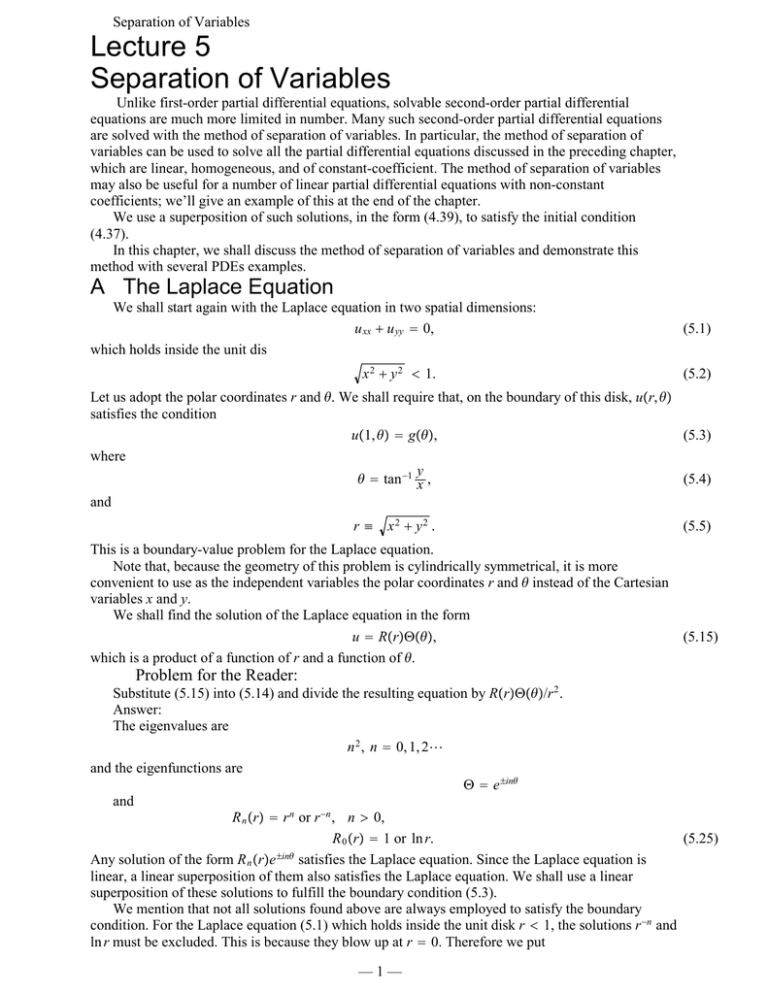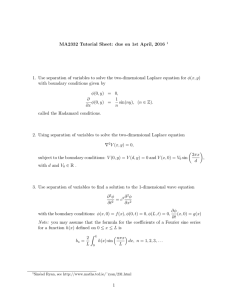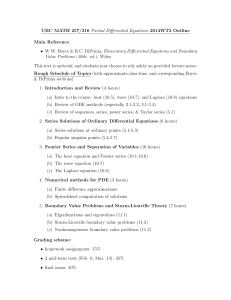Lecture 5 Separation of Variables
advertisement

Separation of Variables Lecture 5 Separation of Variables Unlike first-order partial differential equations, solvable second-order partial differential equations are much more limited in number. Many such second-order partial differential equations are solved with the method of separation of variables. In particular, the method of separation of variables can be used to solve all the partial differential equations discussed in the preceding chapter, which are linear, homogeneous, and of constant-coefficient. The method of separation of variables may also be useful for a number of linear partial differential equations with non-constant coefficients; we’ll give an example of this at the end of the chapter. We use a superposition of such solutions, in the form (4.39), to satisfy the initial condition (4.37). In this chapter, we shall discuss the method of separation of variables and demonstrate this method with several PDEs examples. A The Laplace Equation We shall start again with the Laplace equation in two spatial dimensions: u xx + u yy : 0, which holds inside the unit dis x 2 + y 2 9 1. (5.1) (5.2) Let us adopt the polar coordinates r and O. We shall require that, on the boundary of this disk, uΩr, Oæ satisfies the condition uΩ1, Oæ : gΩOæ, (5.3) where y O : tan ?1 x , (5.4) and rè x2 + y2 . This is a boundary-value problem for the Laplace equation. Note that, because the geometry of this problem is cylindrically symmetrical, it is more convenient to use as the independent variables the polar coordinates r and O instead of the Cartesian variables x and y. We shall find the solution of the Laplace equation in the form u : RΩræ>ΩOæ, which is a product of a function of r and a function of O. (5.5) (5.15) Problem for the Reader: Substitute (5.15) into (5.14) and divide the resulting equation by RΩræ>ΩOæ/r 2 . Answer: The eigenvalues are n 2 , n : 0, 1, 2` and the eigenfunctions are > : e çinO and R n Ωræ : r n or r ?n , n ; 0, R 0 Ωræ : 1 or ln r. (5.25) çinO Any solution of the form R n Ωræe satisfies the Laplace equation. Since the Laplace equation is linear, a linear superposition of them also satisfies the Laplace equation. We shall use a linear superposition of these solutions to fulfill the boundary condition (5.3). We mention that not all solutions found above are always employed to satisfy the boundary condition. For the Laplace equation (5.1) which holds inside the unit disk r 9 1, the solutions r ?n and ln r must be excluded. This is because they blow up at r : 0. Therefore we put —1— Separation of Variables K uΩr, Oæ : A 0 +> ΩA n cos nO + B n sin nOær n . (5.26) 1 Next we turn to the wave equation in two spatial dimensions. This equation is satisfied by the displacement of the surface of a circular drum, which we’ll study in this section. The surface of the drum has circular symmetry, therefore, for the vibration of the drum surface, the spatial variables we shall use are the polar coordinates r and O. The equation is / 2 u ? / 2 u ? 1 /u ? 1 / 2 u : 0, r /r r2 /2O /t 2 /r 2 where u : uΩr, O, tæ, a function of three variables. The PDE is of second order in each of the independent variables. We note that, in this equation, the sign of the coefficient of u tt is opposite to that of u rr . Therefore, the PDE is hyperbolic between the variables t and r. Similarly, it is hyperbolic between t and O. Thus we impose two initial conditions at t : 0 : uΩr, O, 0æ : fΩr, Oæ, (5.32) and u t Ωr, O, 0æ : gΩr, Oæ. (5.33) The PDE is elliptic in the spatial variables, thus we impose the boundary condition uΩ1, O, tæ : 0, (5.34) which is well-posed. The conditions above are physically meaningful as well. Equation (5.34) says that the circumference of the drum is kept fixed at all times, and (5.32) and (5.33) give the initial displacement and the initial velocity of the surface of the drum. We expect from experience that a unique solution of the wave equation will result under these conditions. It is satisfying that such a set of conditions on the solution makes the problem well-posed. Problem for the Reader: Apply the method of separation of variables to the wave equation by putting u : TΩtæRΩræ>ΩOæ, and obtain the equations for TΩtæ, RΩræ and >ΩOæ. Answer: We get uΩr, O, tæ :> øe ic nm t Ωa nm e inO + b nm e ?inO æ + e ?ic nm t Ωc nm e inO + d nm e ?inO æ¿J n Ωc mn ræ. n,m where J n Ωc nm æ : 0. This solution satisfies the wave equation as well as the boundary condition (5.34). And the coefficients a mn , b mn , c mn and d mn are so chosen that the initial conditions (5.32) and (5.33) are satisfied. More detailed discussions and examples can be found in the text book. — 2 — (5.35)



